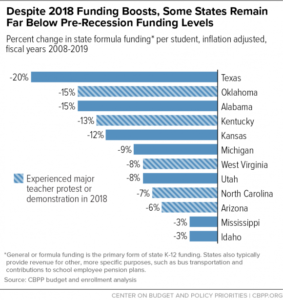Alabama increased state education funding in 2018, but the legacy of years of extreme cuts remains, according to a new report from the Center on Budget and Policy Priorities (CBPP), a nonpartisan research organization based in Washington, D.C.
Alabama increased its K-12 formula funding by 1 percent per student last year. But that funding is still far below pre-recession levels: 15 percent less per student after adjusting for inflation.
“It’s good that state K-12 funding is moving in the right direction again, but Alabama must do much more to get our education system back on track,” Alabama Arise executive director Robyn Hyden said. “Otherwise, we risk falling even further behind states that invest more in their schools.”

Formula funding is the main state revenue source for K-12 schools nationally. It is especially important for schools in high-poverty areas, which educate a disproportionate share of black and Hispanic children. But state cuts have forced many cities and counties to cover more of the cost of education. Between 2008 and 2016, the national average for state funding declined by $167 per student. Average local funding grew by $161 during that time.
“The effects of state funding cuts are evident in teacher pay. Some 42 states cut the average teacher’s salary relative to inflation between 2010 and 2017,” said Michael Leachman, CBPP’s senior director of state fiscal research. “That is why teacher protests have emerged in many states recently.”
Adequate school funding can strengthen state economies. But steep funding cuts make it hard for states to reduce class sizes, extend learning time and enact other reforms to help students thrive.
“Alabama should close income tax loopholes that overwhelmingly benefit wealthy people and large corporations,” Hyden said. “That would allow our state to boost investments in K-12 education and offer pre-K to all families. And it would increase economic opportunities for low-income students and communities of color, who face the greatest barriers to education.”

